
 |
|
 |
 |

jktinst
Jun 28, 2011, 5:29 PM
Post #26 of 41
(6468 views)
Shortcut
Registered: Jun 29, 2010
Posts: 89
|
moose_droppings wrote: ... One comment, the same one people gave mine. If the cord is cut anywhere outside of the leg that is tied in a loop, the whole thing comes undone. I modified mine with two more knotted loops that got clipped which would prevent that...
Could you provide a more detailed description for your system or a link to a previous post? I’m curious. I did run some searches on your username but you’re pretty prolific and I did not find it.
About a year ago I got back into trad leading after yet another longish interruption and read the Long&Gaines book to refresh my memory and get up to date on advances. I really got caught up in the whole srene belay anchor thing. Before diving into the large threads on this topic mentioned in the book, I wanted to see what I might come up with. I quickly (re-)discovered the idea used by Paul Raphaelson and others of turning the sliding X upside-down and extending the loop upward to make the middle arm of a 3-pro anchor sling. However, I also saw the shortcomings that, for the self-equalization to work, the cord must be able to run through the biner of each individual pro (or at least through 2 out of 3, as in the ACR system), which eliminates the possibility of internal redundancy and extension limitation.
I eventually came up with what I felt at first was a significant improvement that maintained the dynamic self-equalization while incorporating internal redundancy and low-extension characteristics, and with a reasonably even load distribution of 37.5-25-37-5. I then started trawling through the threads and found the ACR, the Trango Alpine Equalizer, and others. I also found a description of a neat « binary » system (ie 2 arms off of the central biner that can each be subdivided into two), similar to the Long&Gaines equalette but with better characteristics for dynamic self-equalization. This was described, if I remember correctly, in a healyje post. The binary nature of this system (and of the equalette) means that, for a 3-pro anchor, you get a 50-25-25 or 25-50-25 load distribution (assuming that the angles are sharp enough to be ignored), which is also what you get by stacking two sliding Xs.
I liked the more even distribution that I was getting out of my system but, after further testing, I realized that there were a few too many little things that one needed to pay attention to while setting it up in order to allow it to work optimally. A full description of the basic set-up and the various « little things » in a post would have been quite lengthy and I could just picture getting flamed on the length of the post alone, never mind the unorthodox look of the system.
I also had to admit that 37.5-25-37-5 is not really that much better than 50-25-25 or 25-50-25. For most 3-pro anchors, there is going to be at least one bombproof one on which to clip the « 50 » arm and, for those situations, I concluded that I was happy simply using stacked, extension-limited sliding Xs (except that I use my « sliding double X » instead to avoid the clutch effect and improve the dynamic self-equalization). I also figured that if not a single one of the 3 pros were super-bombproof, it would be a fine time to place a 4th one and go for a 25-25-25-25 load distribution instead. I have not yet found anything better than « healyje-like » systems for this situation. They nail the whole dynamic self-equalization/redundancy/low-extention thing right on. Unfortunately, they require quite a lot of 7mm cord.
Anyway, I look forward to checking out any other systems that I may have missed in my searches.
(This post was edited by jktinst on Jun 28, 2011, 6:22 PM)
|
|
|
 |
 |

 cracklover
cracklover
Jun 28, 2011, 5:40 PM
Post #27 of 41
(6467 views)
Shortcut
Registered: Nov 14, 2002
Posts: 10162
|
jktinst wrote: moose_droppings wrote: ... One comment, the same one people gave mine. If the cord is cut anywhere outside of the leg that is tied in a loop, the whole thing comes undone. I modified mine with two more knotted loops that got clipped which would prevent that... Could you provide a more detailed description for your system or a link to a previous post? I’m curious. I did run some searches on your username but you’re pretty prolific and I did not find it. About a year ago I got back into trad leading after yet another longish interruption and read the Long&Gaines book to refresh my memory and get up to date on advances. I really got caught up in the whole srene belay anchor thing. Before diving into the large threads on this topic mentioned in the book, I wanted to see what I might come up with. I quickly (re-)discovered the idea used by Paul Raphaelson and others of turning the sliding X upside-down and extending the loop upward to make the middle arm of a 3-pro anchor sling. However, I also saw the shortcomings that, for the self-equalization to work, the cord must be able to run through the biner of each individual pro (or at least through 2 out of 3, as in the ACR system), which eliminates the possibility of internal redundancy and extension limitation. I eventually came up with what I felt at first was a significant improvement that maintained the dynamic self-equalization while incorporating internal redundancy and low-extension characteristics, and with a reasonably even load distribution of 37.5-25-37-5. I then started trawling through the threads and found the ACR, the Trango Alpine Equalizer, and others. I also found a description of a neat « binary » system (ie 2 arms off of the central biner that can each be subdivided into two), similar to the Long&Gaines equalette but with better characteristics for dynamic self-equalization. This was described, if I remember correctly, in a healyje post. The binary nature of this system (and of the equalette) means that, for a 3-pro anchor, you get a 50-25-25 or 25-50-25 load distribution (assuming that the angles are sharp enough to be ignored), which is also what you get by stacking two sliding Xs. I liked the more even distribution that I was getting out of my system but, after further testing, I realized that there were a few too many little things that one needed to pay attention to while setting it up in order to allow it to work optimally. A full description of the basic set-up and the various « little things » in a post would have been quite lengthy and I could just picture getting flamed on the length of the post alone, never mind the unorthodox look of the system. I also had to admit that 37.5-25-37-5 is not really that much better than 50-25-25 or 25-50-25. For most 3-pro anchors, there is going to be at least one bombproof one on which to clip the « 50 » arm and, for those situations, I concluded that I was happy simply using stacked, extension-limited sliding Xs (except that I use my « sliding double X » instead to avoid the clutch effect and improve the dynamic self-equalization). I also figured that if not a single one of the 3 pros were super-bombproof, it would be a fine time to place a 4th one and go for a 25-25-25-25 load distribution instead. I have not yet found anything better than « healyje-like » systems for this situation, nailing the whole dynamic self-equilization/redunda. They nail the whole dynamic self-equalization/redundancy/low-extention thing right on. Unfortunately, they require quite a lot of 7mm cord. Anyway, I look forward to checking out any other systems that I may have missed in my searches.
I think I've got a how-to for tying a mooselette somewhere. I'll see if I can dig it up.
GO
|
|
|
 |
 |

 cracklover
cracklover
Jun 28, 2011, 5:51 PM
Post #28 of 41
(6464 views)
Shortcut
Registered: Nov 14, 2002
Posts: 10162
|
To make the mooselette:
1 - Put two overhand knots in the cordelette. These should incorporate the section of line with the joining knot, so as to keep it out of the way. You can do this on the ground. These knots never need to come out.
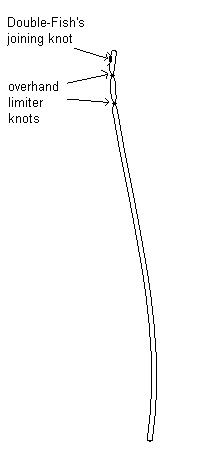
2 - Place three pieces of gear, and put a loop of the cord through each biner, and pull the centers down to a powerpoint like if you were going to make a standard cordelette. Put the strand with the knots on the middle piece.
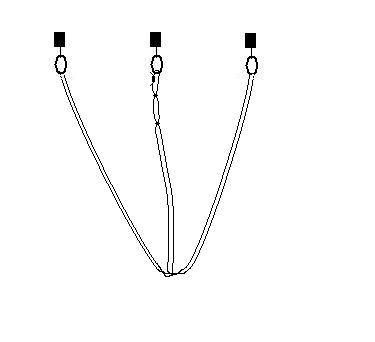
3 - Adjust the two limiter knots so that one is down near the powerpoint, and the other is up near the top.

4 - On each side, clip one biner (or draw, if it needs to be longer) between either of the outside strands, and either of the inside strands. Doesn't matter which one, but in the middle, clip it above the upper limiter knot.
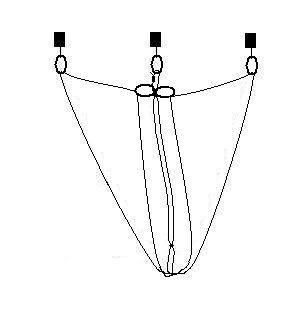
That's it.
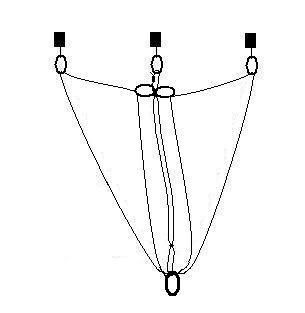
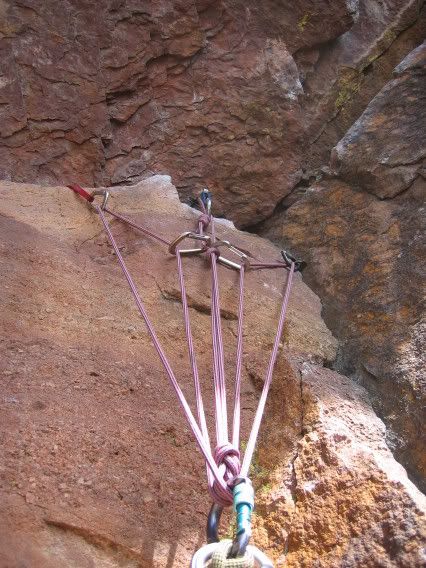
GO
|
|
|
 |
 |

brian_h
Jun 28, 2011, 6:24 PM
Post #29 of 41
(6451 views)
Shortcut
Registered: Aug 24, 2010
Posts: 59
|
I'm not smart enough to start calculating that one out...and it does look nice and fancy, but I see a lot of obtuse angles happening there. I see the benefit of the extension limiting setup, but aren't you creating unnecessarily high loads in your anchor? Just trying to understand all these different anchor setups. I'm still new to trad (spoken "I have no idea what i'm doing") so I say this as a learner.
|
|
|
 |
 |

brian_h
Jun 28, 2011, 6:59 PM
Post #32 of 41
(6430 views)
Shortcut
Registered: Aug 24, 2010
Posts: 59
|
cracklover wrote: Then stick to tried-and-true and let those of us who've been at it for a while work on the cutting edge stuff.
|
|
|
 |
 |

 cracklover
cracklover
Jun 28, 2011, 7:33 PM
Post #33 of 41
(6419 views)
Shortcut
Registered: Nov 14, 2002
Posts: 10162
|
brian_h wrote: cracklover wrote: Then stick to tried-and-true and let those of us who've been at it for a while work on the cutting edge stuff. Thanks, that's really useful advice. I didn't intend for the question to be a personal insult. Hell, I even threw in the newbie line.
I didn't take your post as an insult. Nor did I see any specific questions. What angle is it that has you all worried?
GO
|
|
|
 |
 |

jktinst
Jun 28, 2011, 10:54 PM
Post #34 of 41
(6384 views)
Shortcut
Registered: Jun 29, 2010
Posts: 89
|
Thanks Cracklover. I'd come across the name "mooselette" before but not the description. Now, this does better than the ACR, Trango, etc. on the extension limitation thanks to the two biners linking the centre arm to the outside ones but there is still no internal redundancy. Cut the cord at any point on either of these arms and the whole thing goes or am I missing something?
|
|
|
 |
 |

moose_droppings
Jun 29, 2011, 12:01 AM
Post #36 of 41
(6369 views)
Shortcut
Registered: Jun 7, 2005
Posts: 3371
|
jktinst wrote: Thanks Cracklover. I'd come across the name "mooselette" before but not the description. Now, this does better than the ACR, Trango, etc. on the extension limitation thanks to the two biners linking the centre arm to the outside ones but there is still no internal redundancy. Cut the cord at any point on either of these arms and the whole thing goes or am I missing something?
Take a look at the one I posted. You can cut a strand anywhere, or remove one whole leg and it won't come undone. Also, as I said before, if a rock that size comes through your belay, you've got bigger problems.
|
|
|
 |
 |

jktinst
Jun 29, 2011, 2:37 AM
Post #37 of 41
(6354 views)
Shortcut
Registered: Jun 29, 2010
Posts: 89
|
Sorry, I got distracted by the mooselette and didn't pay attention to the two little back-up loops that keep your system from unraveling if one strand is cut.
Now with your system, it's the extension in case one of the outside pieces pops that's a bit long for my taste. So I guess if I combine your back-up loops for redundancy and the mooselette's extension-limiting biners I'll get the best of both worlds.
I'll want to play with this some more when I have a bit of time (in a couple of weeks) to thoroughly check out the running of the various strands through the central biner with respect to each other, looking for things like whether there's a chance that they might cross each other, preventing equalization.
I realize that using a pear-shaped central biner helps keep all the strands side by side but there could be more to it. I started paying close attention to this kind of things when I attempted to dissect the clutch effect on the regular sliding X. That's what led me to realize with the system I had come up with that apparently minor and easily overlooked differences in how the cord strands are looped and clipped can have a significant effect on how well the system will equalize in a real world situation.
|
|
|
 |
 |

moose_droppings
Jun 29, 2011, 5:19 AM
Post #38 of 41
(6330 views)
Shortcut
Registered: Jun 7, 2005
Posts: 3371
|
jktinst wrote: Now with your system, it's the extension in case one of the outside pieces pops that's a bit long for my taste. So I guess if I combine your back-up loops for redundancy and the mooselette's extension-limiting biners I'll get the best of both worlds.
The bolded in your statement above is incorrect. Those loops not only keep things from unraveling, they also prevent all but a minuscule amount of extension to the power point should any one of the legs blow.
In reply to: So I guess if I combine your back-up loops for redundancy and the mooselette's extension-limiting biners I'll get the best of both worlds.
Actually, they're both mooselettes with different ways of limiting extension.
(This post was edited by moose_droppings on Jun 29, 2011, 5:21 AM)
|
|
|
 |
 |

bearbreeder
Jun 29, 2011, 3:21 PM
Post #39 of 41
(6302 views)
Shortcut
Registered: Feb 2, 2009
Posts: 1960
|
brian_h wrote: cracklover wrote: Then stick to tried-and-true and let those of us who've been at it for a while work on the cutting edge stuff. Thanks, that's really useful advice. I didn't intend for the question to be a personal insult. Hell, I even threw in the newbie line.
one thing to realize ... the fancier the system generally the more time it takes to set up .. and in multipitch wasted time per pitch could mean the difference being benighted or not over say 20 pitches
for most situations nothing more than a fig 8 or overhand tied is needed
|
|
|
 |
 |

jktinst
Jun 29, 2011, 3:26 PM
Post #40 of 41
(6298 views)
Shortcut
Registered: Jun 29, 2010
Posts: 89
|
OK my bad again. I did exactly what I would recommend against if I were describing my own system, which is to eyeball it and jump to conclusions without testing it first.
What didn’t help is that when I did test it, I put the back-up loops on the strand that joins the two outside pros, instead of the ones that go to the middle pro. You get a lot more extension in this configuration.
The main additional observation I have from the preliminary indoor testing so far is that, if one outside pro blows, the central biner goes from being held by three strands of the cord to getting caught by a single one. I’m not exactly comfortable with that. I know that with other systems in “redundancy-type” situations where a strand gets cut, you can end up with the biner on a single strand but that is, first of all, less likely to happen in general (I agree with you on that point) and second, less likely to happen at the same time as a leader fall. On the other hand, extension-type situations where a pro blows, will typically happen when stopping a leader fall. With other systems, the central biner will normally stay on at least two strands. In fact, in the case of the mooselette as described by cracklover, it will stay on all three.
So, although it’s for somewhat different reasons than I had figured at first, I’m still thinking that a combination of both systems, with both the two biners and the two loops as back-ups/extension limiters is better.
|
|
|
 |
 |

jktinst
Jul 17, 2011, 8:12 PM
Post #41 of 41
(6136 views)
Shortcut
Registered: Jun 29, 2010
Posts: 89
|
Just back from the family vacation and with enough time to further test the two types of mooselettes shown above.
A) There does not seem to be, with these systems, the kinds of issues I came up against while testing my earlier system (needing to pay attention to how to clip the central biner into the system and the climbers into the central biner to ensure optimal equalization and eliminate the clutch effect).
Only the strand joining the two outside pros slides through the central biner when it is swung. So, when clipping, it’s probably preferable to make sure that this strand stays to one side of the other two as opposed to being sandwiched between them. If a small central biner is used, there seems to be situations when the two non-sliding strands will cross one another but I have not encountered one where they cross the sliding strand, which is what might result in an undesirable clutch effect.
As mentioned before, a large anodized pear central biner is better able to accommodate all 3 strands side-by-side, which minimizes both sliding strand friction and the possibility of the other two strands crossing each other.
B) Although the “combined system” mentioned in my last post complies with the srene principles, it also combines the set-up complications of both its parent systems: the use of 3 biners from the typical mooselette and the somewhat fiddly adjustments of the back-up loops in moose_droppings’ system.
I hoped that more practice would quickly get me to a point where I would know where to make the knots and how long to make the back-up loops in widely different pro placement configurations to get the right compromise between 1) the width of the arc within which you get the 3-pro dynamic equalization, 2) the extension limitation, and 3) keeping the amount of cord used up to a reasonable minimum, all the while ensuring that the knots are far enough away from their respective biners to avoid bumping into them (and running through them) during an equalizing swing. Unfortunately, I can’t seem to get away from a fair amount of fiddling with the knots and loops in different configurations.
I don’t mind fiddling to get the belay system just right if I’m rigging 4 or 5 not-so-bombproof pros but, for my standard 3-pro set-up, I prefer something quicker and more user-friendly and will stick to the stacked, extension-limited sliding double Xs.
(note: to add a loop on a cord that will be under tension, I really prefer the butterfly knot, which is only marginally more fiddly to move and adjust than the overhand knot).
(This post was edited by jktinst on Jul 18, 2011, 3:17 PM)
|
|
|
 |
 |
|
 |
|

|